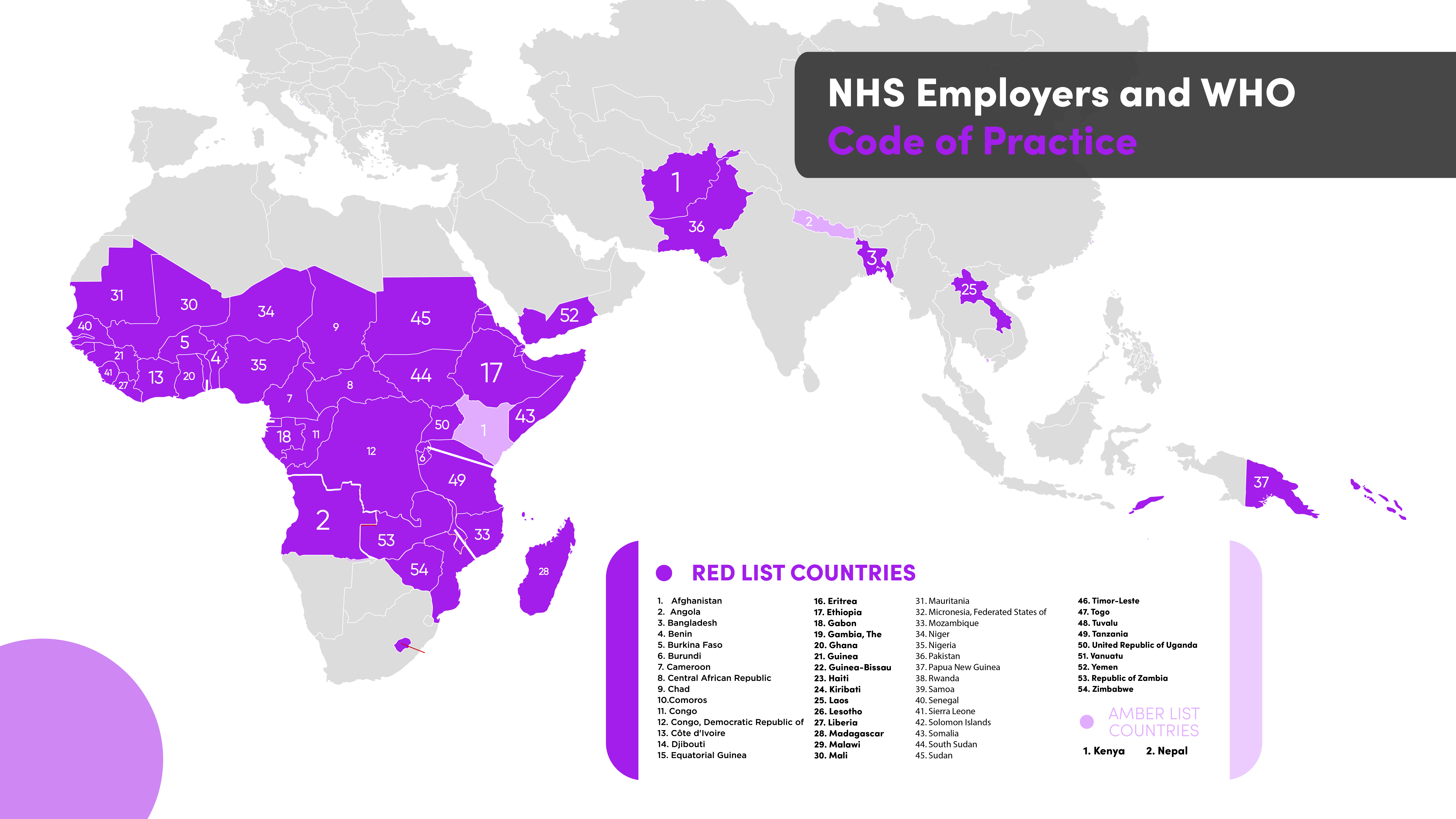
NHS Employers Code of Practice for International Recruitment - Red List for IMG Doctors
03 Apr, 202315 Minutes
As an international medical graduate, you might have heard the term ‘red list’ and, naturally, wonder what that means for your migration to the UK. As part of the NHS Employers Code of Practice for International Recruitment, the red list (also called the WHO Workforce Support and Safeguard List) is a list of countries that cannot be actively recruited by UK health and social care organisations including recruitment agencies. The World Health Organisation decides which countries are on this list and it is constantly being reviewed and updated.
As a fully framework approved and committed member of the ethical recruiters list BDI Resourcing are unable to take part in any active recruitment for candidates residing in red list countries. If your country is on the red list, you might wonder what that means for you. Likely, you’ll have lots of questions: what is it, exactly? How does it affect landing an NHS doctor position? Why is it necessary? The DHSC keeps full guidance on this matter constantly updated in a code of practice; however, we have put this article together to field some of the common questions that we get from red list candidates who we’re unable to represent. Aside from the prohibition of active recruitment, the code of practice also sets out some excellent benchmarks and provides guidance on how to avoid scams, punitive repayment clauses and exploitation. With this in mind, international doctors from all countries (green, amber and red list) will benefit from reading this article.
What is the Ethical Recruitment Red List?
In 2020, the World Health Organisation created the Support and Safeguard list as part of the Code of Practice for international recruitment. This was specifically for the health and social care sector. The list is made up of countries struggling with health workforce challenges, meaning they needed as much of their workforce in their home country in order to reach universal health coverage. As a result, UK health and care organisations can not actively recruit from these countries.

Initially, the red list consisted of 47 countries, but it has since been reviewed. In 2023, the number rose from 50 to 55 countries. Here is a list of all the countries currently on the red list:
African Region
- Angola
- Benin
- Burkina Faso
- Burundi
- Cameroon
- Central African Republic
- Chad
- Comoros
- Congo
- Côte d’Ivoire
- Democratic Republic of the Congo
- Equatorial Guinea
- Eritrea
- Ethiopia
- Gabon
- Gambia
- Ghana
- Guinea
- Guinea-Bissau
- Lesotho
- Liberia
- Madagascar
- Malawi
- Mali
- Mauritania
- Mozambique
- Niger
- Nigeria
- Rwanda
- Senegal
- Sierra Leone
- South Sudan
- Togo
- Uganda
- United Republic of Tanzania
- Zambia
- Zimbabwe
Americas Region
- Haiti
Eastern Mediterranean Region
- Afghanistan
- Djibouti
- Pakistan
- Somalia
- Sudan
- Yemen
South-East Asia Region
- Bangladesh
- Nepal
- Timor-Leste
Western Pacific Region
- Kiribati
- Lao People’s Democratic Republic
- Micronesia (Federated States of)
- Papua New Guinea
- Samoa
- Solomon Islands
- Tuvalu
- Vanuatu
What About Amber and Green?
There are two other lists to consider: amber and green. The amber list consists of countries that have a bi-lateral agreement in place with the UK. While there are still restrictions regarding active recruitment, they are not quite as severe as those for countries on the red list. At this moment in time, there are only two countries on the list:
- Nepal
- Kenya
In terms of the green list, active recruitment is permitted and all countries that don’t feature on the red or amber lists are considered acceptable for active recruitment. However, there are still some parameters set to ensure recruitment is ethical.
Why is the Red List in Place?
The red list is in place to ensure that countries with a shortage of healthcare workers do not suffer because of marketed recruitment. The World Health Organisation specifically chooses the countries on the list, and they only choose the countries that have healthcare systems that require support. That usually means the country has less than 49 doctors, midwives, and nurses per 100,000 people.
This is called ethical recruitment. When a country is on the red list, no NHS organisation or UK recruitment agency can market their jobs directly to the residents of these countries. In turn, more doctors and nurses stay in that country, supporting that healthcare system.
What it Means for IMG Doctors
As an IMG doctor, the red list only affects you if you live in one of the countries listed. If that’s the case, you cannot be actively recruited by any NHS trust or UK organisation – including a recruitment agency. That means you cannot go to a recruitment agency for assistance, as that counts as active recruitment.
Don’t worry – that doesn’t mean you cannot work as a doctor in the UK. You can still apply directly to NHS vacancies, but this should be done completely independently.
IMGs from red list countries must be wary of any agency offering to represent them. Adherence to the red list is a condition of being an approved supplier to NHS procurement frameworks so if active recruitment takes place, chances are the agency are not approved or regulated by the NHS and you’ll want to take extra precautions to make sure you aren’t being scammed, exploited or misrepresented. If you’re in a red list country and a recruitment agency offers to represent you, it could be best to decline their offer.
Active vs Non-active Recruitment
You now know that you cannot be actively recruited if you live in a red list country. What exactly does that mean, though? Of course, you don’t want to break any rules when entering the UK, so it’s important to know how you should go about securing an NHS role independently.
Let’s start by understanding active recruitment. Active recruitment is when UK employment openings in the health and social care sector are directly marketed towards an individual, with the intention for that individual to fill the role. Often, this recruitment marketing is done by recruitment agencies and NHS trusts. With active recruitment, the IMG receives a lot more support and assistance. Here are some examples of active recruitment:
- Incentivisation schemes
- Reaching out directly to an IMG in a red list country
- Advertising directly to candidates
On the other hand, non-active recruitment does not include any support from an NHS trust, agency, or recruiter. Instead, you will have to apply directly to NHS positions without the assistance of a third party. This doesn’t mean you can’t become an NHS doctor; it simply means you must do the whole process independently. The NHS advertise all their positions on NHS jobs in the first instance, so your employment prospects will be just as good.
What if I Actively Pursue an Agency From a Red List Country?
The red list is there to improve the standards of healthcare practices in the countries that need it most. It safeguards and supports those countries, ensuring their healthcare system is protected. Instead of denying people access to working in the UK as a doctor, it’s about ensuring the recruitment process is ethical. Still, we’re often asked if it is ok to work with an agency if a doctor approaches them directly?
The answer is that any involvement from an agency in the recruitment process is looked upon as active recruitment. With that in mind, agencies are unable to represent red list candidates and must point them in the direction of NHS jobs.
Some people are also concerned over whether it discriminates against particular nationalities. However, both the NHS and WHO have stated that the red list is not about nationality; instead, it’s about the country of residence and its healthcare system. Even those who move to a red list country from the UK or another green list country could not later be actively recruited by the NHS if they stay resident there. All recruiters on the ethical recruitment list have further legal obligations to the Equalities Act ensuring you should never experience discrimination.
There are further queries about whether doctors can still use the additional services that agencies offer such as relocation support. Fortunately, outsourced relocation support is allowed under the code of practice however it must be treated separately to the recruitment process and follow a completely independent direct application. Very few NHS Trusts outsource the relocation service alone so you’re more likely to receive the direct support of your employer.
Does the List Get Updated?
Yes – the red list gets reviewed and updated regularly. When reviewing the list, WHO identifies the countries that face the most challenges in their healthcare system and then ensures barriers are put in place to protect it. So, for example, there was an amendment this year (2023) which saw the red list grow from 50 countries to 55. WHO added those five countries to the list because they had less than 49 doctors per 100,000 capita.
With these constant reviews and amendments, the red list serves its purpose of protecting the healthcare systems that don’t have enough doctors, nurses, and midwives.
It’s important to know whether your country is on the red list so that you know the best way to apply for an NHS role. If you are on the red list, you cannot work with a recruitment agency. However, that doesn’t mean you can’t join the NHS if you wish to do so independently. You can keep up with the current red list of countries on the UK Government website.
In Summary
The idea of a red list might seem a little confusing, but you don’t need to worry – while being on the list does mean the NHS will not actively recruit you, that doesn’t mean you cannot immigrate if you wish. Here are some key points to keep in mind:
NHS employers cannot actively recruit from red list countries.
No NHS employer or agency can actively recruit (directly reach out or advertise) IMGs from any countries listed on the red list.
IMGs from red list countries can still apply directly to NHS vacancies.
Nothing is stopping you from applying directly to an NHS vacancy, no matter where you live! As long as you meet the other criteria, you can work for the NHS.
The list changes over time.
The World Health Organisation constantly reviews the red list to ensure it’s up to date. That might involve adding or removing countries depending on their healthcare system’s situation.
Check the guidance on applying from overseas.
The Department of Health and Social Care have set out excellent guidance on applying for health and social care jobs in the UK from abroad. This includes support on how to avoid scams, punitive repayment clauses and illegal agency fees.
As you can see, the red list doesn’t prevent anyone from working for the NHS; it just prevents NHS employers and recruiters from actively marketing towards those countries. It also safeguards doctors from all countries by encouraging high standards and benchmarks for ethical recruitment. If you are considering becoming an NHS doctor, you should first check whether your home country is on the red list, as that will determine whether you can use a recruitment agency or whether you need to apply for jobs directly.


